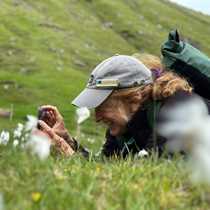A
Trillium blooms in the dappled shadows of the forest floor. While this may not seem spectacular in itself, and could easily be overlooked, it was not missed by the keen eye of Meriwether Lewis. He had kept track of the changing of the seasons many times before, not by checking off the days on a calendar, but through observations; the migrations of birds, the changing colors of leaves and as shown here, the blossoming of flowers.
Trillium ovatum, also known as "wake-robin," is a flower that blooms early in March and into May. It heralds the beginning of spring. Lewis read with the appearance of this flower that winter was over and it was time to head east, it was time to go home. It had been a very wet winter at Fort Clatsop, and it would be easy to imagine a slight smile creeping across the face of Captain Lewis as he walked through the woods and came upon the blooming
Trillium. He collected a specimen of this flower on April 10, 1806, and added it to the other 200 plus plants so carefully collected, pressed, repeatedly dried and carried from the western to the eastern shore of North America.
The flowers and the tall trees of the west coast also tell us our expedition "In the Wake of Lewis and Clark" is coming to a close. While we enjoy this afternoon aboard the Sea Bird, we know we can continue with the Corps of Discovery through the many excellent books written of the journey. We have traveled through history as well as through a variety of landscapes these past few days. As we read further, our travels will give us a reason to pause and reflect. Just as the expedition did, we stood amongst the basaltic boulders at Rock Fort, reveled at the snow capped peak of Mt. Hood, gazed at the "most beautiful" Multnomah Falls, walked the sandy shores of the Pacific coast, and like Meriwether Lewis, gazed upon the fragile white petals of the Trillium.




